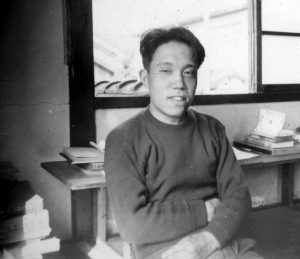My Life — Interview with Hiromu Morishita (1930–), A-bomb survivor and teacher, Part 7: Struggle with tuberculosis
Apr. 28, 2022
Escaped from deathbed and became teacher
From the spring of 1946, Hiromu Morishita stayed at the dormitory of Gion Girls’ High School, now the AICJ Junior & Senior High School, located in Hiroshima’s Asaminami Ward.
When my father began teaching at the school, we kids, my two sisters and I, were allowed to live with him in a six-tatami-mat room in the school’s dormitory. We grew potatoes and other things in the schoolyard. Using a stove in the school’s kitchen, our father mainly cooked our meals.
In 1948, I graduated from junior high school as a fifth-year student and went on to attend Hiroshima Higher Normal School. However, because of education-system reforms, I took another entrance examination for the faculty of literature at the new Hiroshima University the next year, in 1949, and was accepted there. The university was located in the area of Higashisenda (now part of Hiroshima’s Naka Ward). I made friends and enjoyed going around visiting their boarding houses. While at university, I discovered the joy of mountain climbing. I was invited to join the alpine club and climbed Mt. Yarigatake and other mountains.
He developed tuberculosis as a third-year university student.
I caught a cold while in the mountains and was told by my physician to “rest immediately.” However, I stupidly continued to push myself hard in preparation for school exams. I ultimately ended up taking a year off from school and isolating in a corner room of the dormitory. Every six months, I underwent treatment for pneumothorax at a sanatorium in the area of Higashihiroshima. My father even borrowed money to get me expensive medicine.
Around that time, I started writing tanka poems, recommended by a friend of mine. I also joined a tanka group. In those days, tuberculosis was like cancer, making everyone think about death. That is why so many of my writings involved pain and suffering. Soon, I also began to write poetry, several collections of which I eventually published.
My illness dragged on. After I returned to school, the tuberculosis returned, and I had to take another year off. During my recovery, I started cutting out articles from newspapers. As a result, I began to think deeply about such issues as the Korean War and the U.S. hydrogen bomb testing. The forcibly conducted hydrogen bomb tests made me fear that “the earth could melt.” That situation might have been one of the reasons I started my involvement in the peace movement.
After graduation, he started teaching at the same school at which his father had taught, which became known as Oshimo Gakuen Gion Girls’ High School.
My graduation was delayed two years. Finding a job was a source of worry for me. It was my father who gave me an opportunity. He said, “Learn calligraphy. Skills are always useful.” I returned to school and worked hard to get the required credits that enabled me to teach Japanese language and calligraphy at Oshimo Gakuen Gion Girls’ High School. Because I was still undergoing treatment for tuberculosis, I was only able to teach two or three days a week. Nevertheless, I was ecstatic about being able to get out of bed and work. I was what people often referred to in those days as someone who became a teacher as a fallback option because teaching was the only thing they could do. That’s also what I believed I did.
(Originally published on April 28, 2022)








